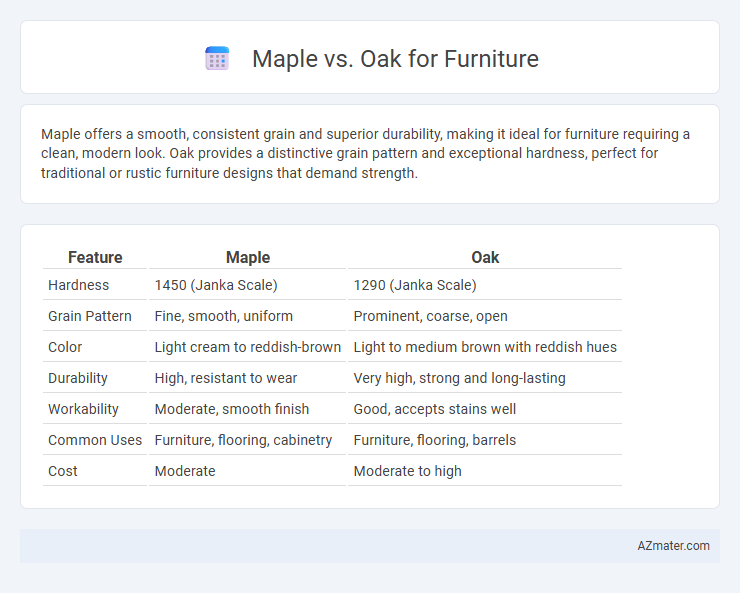Maple offers a smooth, consistent grain and superior durability, making it ideal for furniture requiring a clean, modern look. Oak provides a distinctive grain pattern and exceptional hardness, perfect for traditional or rustic furniture designs that demand strength.
Table of Comparison
| Feature | Maple | Oak |
|---|---|---|
| Hardness | 1450 (Janka Scale) | 1290 (Janka Scale) |
| Grain Pattern | Fine, smooth, uniform | Prominent, coarse, open |
| Color | Light cream to reddish-brown | Light to medium brown with reddish hues |
| Durability | High, resistant to wear | Very high, strong and long-lasting |
| Workability | Moderate, smooth finish | Good, accepts stains well |
| Common Uses | Furniture, flooring, cabinetry | Furniture, flooring, barrels |
| Cost | Moderate | Moderate to high |
Introduction to Maple and Oak Furniture
Maple furniture is prized for its durability and fine, uniform grain, making it ideal for pieces that require strength and a smooth finish. Oak furniture features a prominent grain pattern and natural resilience, commonly used in traditional and rustic styles that highlight its rich texture. Both hardwoods offer excellent longevity and distinct aesthetics, catering to various design preferences and functional needs.
Key Differences Between Maple and Oak Wood
Maple wood is denser and harder than oak, offering a smoother texture and lighter color ideal for modern, sleek furniture designs. Oak features a prominent grain pattern and a warmer, reddish-brown hue, making it a popular choice for traditional, rustic furniture styles. Durability-wise, oak is more resistant to wear and moisture, while maple provides better resistance to dings and scratches, influencing the choice based on furniture usage and aesthetic preference.
Durability Comparison: Maple vs Oak
Maple furniture is known for its exceptional hardness, rating around 1450 on the Janka hardness scale, making it highly resistant to dents and scratches. Oak, with a Janka hardness of approximately 1290 for red oak and 1360 for white oak, offers strong durability but slightly less than maple. Both woods provide excellent longevity, but maple's tighter grain structure often results in better resistance to wear and tear over time.
Appearance and Grain Patterns
Maple furniture is characterized by a smooth, consistent grain pattern with light, creamy hues that enhance modern and minimalist interiors. Oak displays prominent, coarse grain with distinct rays and knots, offering a rustic and traditional aesthetic. The choice between maple and oak depends on the desired visual impact, with maple providing subtle elegance and oak delivering bold texture.
Workability and Craftsmanship
Maple offers exceptional workability due to its fine, uniform grain and smooth texture, making it ideal for intricate furniture craftsmanship and detailed carvings. Oak, known for its coarse grain and open pores, provides robust durability but requires more effort and specialized tools to achieve precise finishes. Crafting with maple allows for cleaner cuts and a polished appearance, whereas oak excels in rustic and sturdy furniture designs with a distinct, textured aesthetic.
Cost Analysis: Maple vs Oak Furniture
Maple furniture typically costs less than oak due to its faster growth rate and abundance, making it a more budget-friendly option for quality hardwood pieces. Oak, especially white oak, commands higher prices because of its durability, distinctive grain patterns, and stronger resistance to wear, which increases its value in luxury or high-traffic furniture. The cost difference between maple and oak can range from 15% to 40%, with oak investments often yielding longer-lasting furniture with a more classic aesthetic.
Versatility and Style Options
Maple wood offers exceptional versatility with its fine, uniform grain and light color, making it ideal for a wide range of furniture styles from modern to traditional. Oak provides a richer, more pronounced grain pattern and natural durability, preferred for rustic or classic pieces that require strong structural integrity. Both woods accommodate various finishes and stains, allowing customization to suit diverse design preferences and interior aesthetics.
Maintenance and Longevity
Maple furniture offers superior durability with a dense grain that resists scratches and dents, requiring minimal maintenance beyond regular dusting and occasional polishing. Oak furniture, known for its robust hardness and distinctive grain patterns, demands consistent care such as cleaning with a damp cloth and periodic sealing or waxing to prevent moisture damage and maintain its longevity. Both hardwoods provide long-lasting furniture solutions, but maple's tighter grain structure generally offers better resistance to wear over time compared to oak.
Environmental Impact and Sustainability
Maple furniture production typically involves faster tree growth and higher yield per acre compared to oak, resulting in a lower environmental footprint. Oak trees mature more slowly but provide greater durability, which can extend the lifespan of furniture and reduce replacement frequency. Sustainable sourcing certifications, such as FSC, are crucial for both maple and oak to ensure responsible forest management and minimize ecological impact.
Which is Better for Furniture: Maple or Oak?
Maple offers a smooth, fine grain and high durability, making it ideal for furniture that requires a clean, modern look with excellent resistance to wear and dents. Oak features a prominent grain pattern and exceptional strength, favored for traditional, rustic furniture styles and heavy-use pieces due to its robustness and resistance to moisture. Choosing between maple and oak depends on the desired aesthetic and usage requirements, with maple suited for sleek designs and oak preferred for sturdy, classic furniture.

Infographic: Maple vs Oak for Furniture
 azmater.com
azmater.com